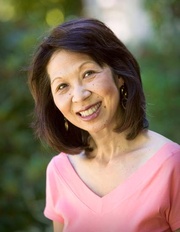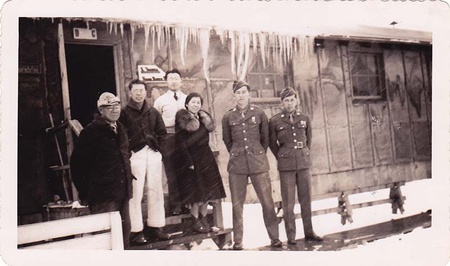“I can still recall the pit in my stomach as I read full-page ads urging Japanese American residents not to return to their community from the camps where they had been exiled,” scholar and author Linda Tamura says.
Tamura had been researching her grandmother’s story, which led to Tamura’s previous book, The Hood River Issei: An Oral History of Japanese Settlers in Oregon’s Hood River Valley.
“I recall sitting in the basement of the Hood River County Library surveying wartime issues of The Hood River News,” says Tamura. “News headlines even used the ‘J’ word. But most telling was what I read underneath: the names of hundreds of community members, including neighbors and relatives of my classmates. It was hard for me to imagine that this had happened in my community—and to my parents, grandparents, and relatives.”
For the Japanese Americans forcibly removed from their homes during the World War II mass-incarceration because of anti-Asian hysteria, the warning from the white community was clear: don’t come home. But less clear was the impact that these public, openly hostile sentiments had on their targets—including many who were highly decorated military veterans.
“When I began asking questions, I heard guarded responses,” says Tamura. “People were reluctant to talk.”

"Nisei Soldiers Break Their Silence", featuring a photo of 4 Hood River Nisei vets at their base camp at Camp Roberts, California.
Tamura, whose father was a veteran, knew that she had uncovered a painful but important story. The result is a new book, Nisei Soldiers Break Their Silence: Coming Home to Hood River.
The book explores a dark chapter of Oregon’s history, in which town leaders stripped the names of Japanese American soldiers from a local war memorial. The racist treatment of the veterans was highly publicized and reviled across the country. But through her research, Tamura aimed to reveal the human stories behind the headlines.
“There had been little written about the Japanese American experience in classroom textbooks,” says Tamura, who is a professor of education at Willamette University in Salem, Oregon. “And, though I began to understand that my own community gained national notoriety for its wartime actions, there was little in the literature.”
“So, despite my limited background, I became committed to asking questions, investigating the paper trail, and learning about how my community had gained such a notorious wartime reputation,” Tamura says. “I was also able to view files of the veterans’ organization that had led the campaign against the return of Nikkei (people of Japanese descent). This study led to my own education about the war, the military, the Nikkei experience, and my hometown.” It was this closeness to Hood River that gave the subject matter extra meaning for Tamura.
“I’m an orchard kid from Hood River, where I grew up on my parents’ (and grandparents’) farm,” Tamura explains. “My sisters and I played in the apple and pear orchard when we were toddlers before we became employees. Twenty-five cents an hour at first—drastic overpayment! Our first jobs were scraping tree bark and thinning young fruit, and then eventually we moved water sprinklers and loaded fruit boxes onto Dad’s trailer. We learned how to drive while shifting gears on the tractor and jeep—and occasionally running over young seedlings. Our parents’ work ethic on the farm was strong—and we learned the importance of working together with our parents, cousins, and aunts and uncles.”
The project ultimately became a multiyear labor of love. But bringing the book to publication proved challenging.
“I began my interviews in 2000, with three very private and initially reluctant Nisei (second-generation Japanese American) veterans,” says Tamura. “Eventually I was able to speak with members of their families, other veterans, and community members to gain other views. Because of the veil of silence as well as my own schedule demands, the process of interviewing and drafting took eight years.”
“Finding the right match with a publisher is so critical,” Tamura notes. “Three years ago I had the chance to sign an advance contract if I could focus on the Hood River case study by cutting some sections of my manuscript as well as references. Ultimately I recognized that the background information and citations were crucial to help readers understand the context of what occurred in Hood River. It was difficult to begin the process again but I’m very pleased with the work of the University of Washington Press.”
One by one, Tamura honed her accounts of Nisei veterans’ stories. And over time, Tamura was gratified to notice that the veterans were gradually gaining their overdue recognition for wartime heroism. “The story of Nisei veterans is unfolding—and their stories are finally being told,” she says. Her book also includes experiences of veterans who were sequestered during Pres. Franklin Roosevelt’s visit to their army base—and their subsequent charge of insubordination.
“I’ve not served in our nation’s armed forces,” Tamura comments. “But, through learning of the fearlessness and the fears, the feats and the discrimination, the worries and the challenges of Nisei veterans and their families, I’m a bit in awe. I don’t know how they withstood what they did. And, because they’re reluctant to tell of their experiences, I feel honored that these veterans trusted me to listen to and convey their words. While I know that each veteran’s experience is different, I think that young people serving in the armed forces—and those who are not—can be inspired by those who came before them and who served our country. And I value the stories they too are sharing.”
Tamura observes that the experience of researching and writing about veterans has given her a new view of her own father as well. “When we were kids, Dad always bought red, plastic poppies to share with us on Veterans Day. He bowled on the VFW team each week and wore his army hat to special veterans’ events. I remember being proud, though I had little understanding of how he’d served or even what a veteran was. Eventually I learned how Dad had volunteered for the army a week after Pearl Harbor was bombed, because, as a citizen, he felt it was his duty.”
“Now I buy poppies every year on Veterans Day,” says Tamura.
* * *
Books & Conversations: Nisei Soldiers Break Their Silence by Linda Tamura
At the Japanese American National Museum
Sunday, November 11, 2012
2:00 PM—4:00 PM
Author Linda Tamura will speak about her book at the Japanese American National Museum for a special Veterans’ Day program.
The book is available from the Japanese American National Museum Store.
© 2012 Japanese American National Museum








